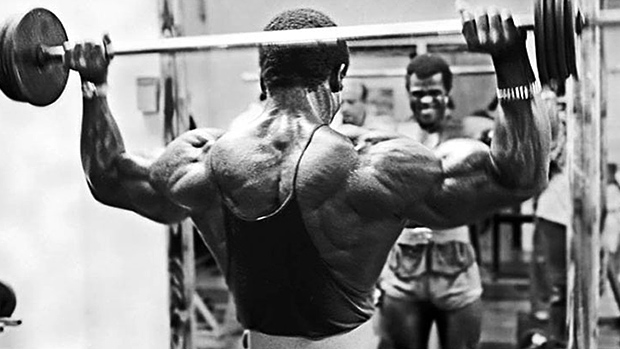Feeling Fatigued?
As resistance trained athletes, fatigue is no stranger to us. It's
very common (and expected) for performance to decline as a given
workout progresses. However, for some, this drop-off in performance
occurs much sooner and is much more pronounced than it is with
others.
For example, say you're performing 5 sets of bench presses with
a 12RM load. On your first set, achieving 12 reps is hard, but not
impossible; on your 5th set, achieving 6-7 reps reps is a struggle.
Sound familiar? What is it that causes such a profound waning
effect even when substantial rest periods (more than 90 seconds)
are utilized?
Well, it's not just one thing; in fact, it could be any number
of things. Great answer, huh? Don't worry, I'm not going to leave
you hanging. In this article I'll enumerate the possibilities and
also provide you with recommendations to counteract these
contributing factors.
Even if you don't suffer from Extreme Performance Decline
Syndrome (EPDS), you can still benefit from the info presented here
as it'll help you to bang out a few extra reps every workout.
And who doesn't want that?
1. You're out of shape!
This one is rather obvious, however, some individuals think the
fact that they can't even run a mile without stopping twelve times
isn't going to affect their muscle building efforts. Sorry, if
you're huffing and puffing between sets in an attempt to catch your
breath, your performance is going to suffer.
Solution: Work on improving your level of fitness by means of HIIT
cardio (high intensity interval training). An example of a HIIT
sprint workout is to sprint for 20 seconds and follow it up with 20
seconds of active recovery (i.e. walking). That's one interval.
Now, repeat this as many times as you can.
Try working up to 15 total intervals. In time, both your aerobic
and anaerobic conditioning will improve. Do this and a poor level
of conditioning will no longer impede your progress!
2. You possess a high percentage of Type IIB muscle
fibers.
Type IIB muscle fibers are explosive in nature and as such are
great for black belt karate kicks and/or power cleaning 1000
pounds. However, they aren't so great when it comes to your
traditional 8-12 rep hypertrophy program because they have a low
mitochondrial content and fatigue rather quickly (2).
Individuals with a high percentage of Type IIB muscle fibers in
comparison to Type I and Type IIA fibers may experience difficulty
in maintaining a given exercise prescription when working in higher
rep ranges.
Solution: Pick your parents more wisely in your next life. No, just
kidding. This actually isn't a bad thing as Type IIB fibers have
the greatest hypertrophy potential of all muscle fibers.
Having said that, if you feel you're a more "explosive" trainee
and don't fair well with higher rep protocols, try experimenting
with lower rep, but still high volume programs for hypertrophy
purposes (i.e. 12x4; four waves of 3,2,1; 15x2; repeated singles
with minimal rest, etc.)
3. Your nutrition is inadequate. More specifically, you're not
consuming enough carbs.
Upwards of 80% of the ATP needed for muscle contraction in a
typical bodybuilding workout is provided by means of anaerobic
glycolysis (3,4). Three sets of 10-12 reps will yield ~24% local
reduction in muscle glycogen content (assuming the subject's muscle
glycogen stores are full at the start of the workout) and ~38%
after six sets (5).
If starting muscle glycogen content is low (due to insufficient
carbohydrate intake), performance will indeed be negatively
affected. Similarly, studies have shown that high initial muscle
glycogen levels increase time to exhaustion during intermittent
exercise (6,7,8,9,10,11,12).
Solution: Use a fork and/or spoon and put food in your mouth
regularly. Carbohydrate intake in general should be around two
grams per pound of LBM (lean body mass) to ensure muscle glycogen
stores are topped off before your workout begins.
 |
Also, consuming a carbohydrate beverage immediately before or
during your training session significantly, positively affects the
number of sets and reps you can perform before exhaustion
(8,9,12).
4. Your body isn't efficient at clearing lactic
acid.
Lactic acid accumulation yields a high H+ concentration which in
turn contributes to fatigue by interfering with several crucial
steps in the contraction process (mainly reducing the force
generated at a given Ca++ concentration and inhibiting sarcoplasmic
reticulum Ca++ release) (2).
If your body isn't efficient at clearing lactic acid (i.e. most
of the lactic acid isn't removed before the start of your next work
set), performance will drop off at an accelerated rate.
Solution: Shorten your rest periods and/or spend more time in the
higher rep ranges. The only way your body will improve its ability
to clear lactic acid is by teaching it to do so. In time, your body
will become more efficient at removing lactate and this will no
longer be a limiting factor in your training. It's also possible to
buffer lactic acid through supplementation (more on this
later).
5. Your CNS needs a jolt!
Several studies have suggested that alterations in central
nervous system arousal can facilitate motor unit recruitment to
increase strength and alter the state of fatigue (13,14,15). That
is, the greater the arousal or alertness, the greater the
performance (to a point).
Solution: Try a nootropic supplement like Power Drive and/or SPIKE.
While one isn't technically a CNS stimulant (Power Drive),
both will increase alertness and arousal in the brain to a high
degree.
A more basic choice if on a budget is caffeine as it's a central
nervous system stimulant that's been shown to increase both arousal
and alertness as well (16). A dose of 2-4mg/lb of LBM one hour
before your training session should suffice (17,18).
 |
6. You're experiencing normal, physiological, neuromuscular
fatigue.
Any time you perform repeated bouts of high intensity exercise,
fatigue is going to set in. This is unavoidable. Now, that's not to
say you can't do anything to improve the rate of fatigue caused by
these unavoidable factors. Below is a list of the possible
contributing factors to normal neuromuscular fatigue and what you
can do about it.
A) Failure at the neuromuscular junction. At one time, a certain
muscle physiologist theorized that the neuromuscular junction was a
site of fatigue (2), but then someone actually performed a couple
of studies and found out that the first guy was an idiot
(19,20).
Solution: You don't have to worry about this one because the first
guy was an idiot.
B) Inability of the sarcolemma to maintain Na+ and K+
concentrations. During repeated stimulation, K+ accumulates outside
the cell membrane and decreases inside the cell. This results in a
depolarization of the cell and a reduction in action potential
amplitude (2).
Solution: Sorry, there isn't much you can do about this one. Having
said that, consuming inadequate amounts of sodium daily can
potentially make the situation worse, so strive to consume 2g for
each liter of water you ingest.
C) Depleted creatine phosphate (CP) stores. CP is needed to
convert adenosine diphosphate (ADP) to adenosine triphosphate (ATP)
in order to support muscular contractions during short-duration
high intensity exercise. When CP is depleted, ATP regeneration is
slowed, which is a contributing factor to fatigue (2).
Solution: Supplement with creatine. If you choose to
load creatine, aim to ingest 20-25g daily separated into 3-5g doses
for six days. Doing so will increase muscle creatine concentration
by upwards of 20% (21).
You can also choose not to load and still achieve the same
levels by consuming 3-5g daily; however, it'll take significantly
longer (28 days) to obtain the same levels as you would if you
chose to load. Also, it's recommended to cycle creatine in a
fashion of two months on and one month off in an attempt to prevent
creatine transporter down-regulation (22,23).
D) Change in acid-base balance. Some lactic acid accumulation is
inevitable even in trainees whose lactic acid clearance
capabilities are above average. An increased lactate concentration
shifts the body into an acidotic state, a probable cause of fatigue
during high intensity intermittent exercise (24,25).
Solution: Supplement with sodium bicarbonate (baking soda). One of
the body's natural buffering agents is bicarbonate, which helps
offset the drop in pH that contributes to muscular fatigue.
Supplementation with sodium bicarbonate has been shown to improve
performance (particularly when an interval style training protocol
is used) by shifting the body into an alkalotic state, thus
increasing the body's ability to buffer lactic acid (26).
 |
Try consuming 300mg/kg of LBM one to two hours prior to your
exercise session with at least one liter of water (24,26). Be
forewarned, side effects such as gastrointestinal discomfort,
bloating, and diarrhea may occur, particularly if sufficient water
isn't taken along with the baking soda.
With that said, recent research at the human performance
laboratory of my alma mater, The College of New Jersey, has given
merit to another lactic acid buffering compound which initially
seems to be more effective than baking soda without the
aforementioned side effects (27). The compound is known as beta-alanine and works by increasing intracellular
carnosine, a natural H+ buffer.
7. You're suffering from heavy metal toxicity.
A prominent strength coach once noted that unsuspected toxicity
levels, such as elevated aluminum levels, can result in increased
muscular fatigue.
Solution: Throw away your Metallica albums and drink bottled water
as opposed to Diet Coke.
Closing Thoughts
While fatigue can't be completely prevented or avoided, it can be
significantly lessened by following the recommendations presented
in this article. You know what they say: knowledge isn't
power, applied knowledge is power. Go get
'em.
References
1. Okay, I just made that up to sound cool, but the rest are
real, I swear.2. Power, Scott K, and Howley, Edward T. Exercise Physiology:
Theory and Application to Fitness and Performance. New York:
McGraw-Hill, 2001.3. MacDougall JD, Ray S, Sale DG, et al. Muscle substrate
utilization and lactate production duringweightlifting. Can JAppl
Physiol 1999; 24: 209-154. Medbo JI, Tabata I. Anaerobic energy release in working muscle
during 30 s to 3 min of exhausting bicycling. J Appl Physiol 1993;
75: 1654-605. Robergs RA, Pearson DR, Costill DL, et al. Muscle glycogenolysis
during differing intensities of weight-resistance exercise. J Appl
Physiol 1991; 70: 1700-66. Balsom PD, Gaitanos GC, Soderlund K, et al. High-intensity
exercise and muscle glycogen availability in humans. Acta Physiol
Scand 1999; 165: 337-457. Davis JM, Jackson DA, Broadwell MS, et al. Carbohydrate drinks
delay fatigue during intermittent, high-intensity cycling in active
men and women. Int J Sport Nutr 1997; 7: 261-738. Lambert CP, Flynn MG, Boone JB, et al. Effects of carbohydrate
feeding on multiple bout resistance exercise. J Appl Sport Sci Res
1991; 5: 192-9. Nicholas C, Tsintzas K, Boobis L, et al.
Carbohydrate-electrolyte ingestion during intermittent
high-intensity running. Med Sci Sports Exerc 1999; 31: 1280-610. Haff GG, Koch AJ, Potteiger JA, et al. Carbohydrate
supplementation attenuatesmuscle glycogen loss during acute bouts
of resistance exercise. Int J Sports Nutr Exerc Metab 2000; 10:
326-3911. Haff GG, Stone MH, Warren BJ, et al. The effect of carbohydrate
supplementation on multiple sessions and bouts of resistance
exercise. J Strength Cond Res 1999; 13: 111-712. Maganaris CN, Maughan RJ. Creatine supplementation enhances
maximum voluntary isometric force and endurance capacity in
resistance trained men. Acta Physiol Scand 1998; 163: 279-8713. Ikai, M., and K. Yabe. Training effect of muscular endurance by
means of voluntary and electrical stimulation. Euro J Appl Phys
28:55-60. 1969.14. A central nervous system component in local muscle fatigue.
Euro J Appl Phys 38: 9-15. 197815. Asmussen, E., and B. Mazin. Recuperation after muscular fatigue
by "diverting activities" Euro J Appl Phys 38: 1-7. 1978.16. Nehlig, A., and G. Debry. Caffeine and sports acitivity: a
review. Int J Sport Nutr 5:94-101. 1995.17. Clarkson, P.M. Nutritional ergogenic aids: Caffeine. Int J
Sport Nutr 3:103-111. 199318. Graham, T.E., and L.L. Spriet. Caffeine and exercise
performance. Gatorade Sports Science Exchange 9(1). 1996.19. Bigland-Ritchie, B. EMG and fatigue of human voluntary and
stimulated contractions. Human Muscle Fatigue: Physiological
Mechanisms, 130-56. London: Pitman Medical. 1981.20. Merton, P.A. Voluntary strength and fatigue. J Phys 123:553-64.
1954.21. Greenhaff PL, Bodin K, Soderlund K, et al. Effect of oral
creatinesupplementation on skeletal muscle phosphocreatine
resynthesis. Am J Physiol 1994; 266 (5 Pt 1): E725-3022. Hultman E, Soderlund K, Timmons JA, et al. Muscle creatine
loading in men. J Appl Physiol 1996; 81: 232-723. Guerrero-Ontiveros ML,Walliman T.Creatine supplementation in
health and disease. Effects of chronic creatine ingestion in vivo:
down-regulation of the expression of the creatine transporter
isoforms in skeletal muscle. Mol Cell Biochem 1998; 184: 427-3724. Horswill, C.A. Effects of bicarbonate, citrate, and phosphate
loading on performance. Int J Sport Nutr. 5:S111-S119. 1995.25. Kanter, M.M., and M.H. Williams. Antioxidants, carnitine, and
choline as putative ergogenic aids. Int J Sport Nutr 5:S120-S131.
1995.26. Matson, L.G., and Z.V. Tran. Effects of sodium bicarbonate
ingestion on anaerobic performance: A meta-analytic review. Int J
Sport Nutr 3:2-28. 1993.27. Hoffman J et al. Effect of creatine and
beta-alanine supplementation on performance and endocrine responses
in strength/power athletes. Int J Sport Nutr Exerc Metab.
2006 Aug;16(4):430-46.





